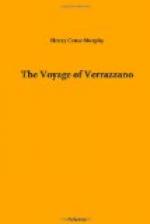“An Salutis, 1509. Seven savages were brought to Rouen with their garments and weapons from the island they call Terra Nova. They are of a dark complexion, have thick lips and wear marks on their faces extending along their jaws from the ear to the middle of the chin like small livid veins. Their hair is black and coarse like a horse’s mane. They have no beard, during their lives, or hairs of puberty. Nor have they hair on any part of their persons, except the head and eye-brows. They wear a girdle on which is a small skin to cover their nakedness. They form their speech with their lips. No religion. Their boat is of bark and a man may carry it with one hand on his shoulders. Their weapons are bows drawn with a string made of the intestines or sinews of animals, and arrows pointed with stone or fish-bone. Their food consists of roasted flesh, their drink is water. Bread, wine and the use of money they have none. They go about naked or dressed in the skins of bears, deer, seals and similar animals. Their country is in the parallel of the seventh climate, more under the west than France is above the west.” Plus sub occidente Quam GALLICA REGIO supra OCCIDENTEM. By “west” here is meant the meridional line, from which longitude was calculated at that time, through the Island of Ferro, the most westerly of the Canary islands, and the idea here intended to be conveyed is that the country of these Indians was further on this side than France was on the other side, of that line.
This description, as well as the name, Terra Nova, indicates the region of Newfoundland as the place from whence these Indians were taken. According to the tables of Pierre d’Ailly, the seventh climate commences at 47 Degrees 15’ N. and extends to 50 Degrees 30’ N. beginning where the longest day of the year is 15 hours and 45 minutes long. (Imago MUNDI, tables prefixed to the first chapter.) This embraces the greater part of the southerly and easterly coasts of Newfoundland. The practice of tattooing their faces in lines across the jaw, as here described, was common to all the tribes of this northern coast, the Nasquapecs of Labrador, the red Indians of Newfoundland and the Micmacs of Cape Breton and Nova Scotia. It was from the use of red ochre for this purpose that the natives of Newfoundland obtained their designation of red Indians. The Micmacs used blue and other colors; hence it would appear from the circumstance of the marks upon these Indians being livid (LIVIDAE) or blue, like veins, that they belonged to the tribes of Cape Breton. (Hind’s Labrador II, 97-110. Purchas, III. 1880-1. Denys. (Hist. Nat. De L’AMERIQUE Sept. II, 887.))]




